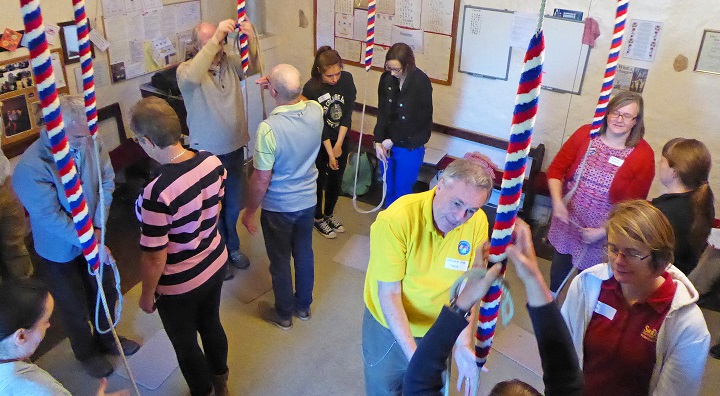M1: 5 May 2018 - Oxted
People often tell me “there’s always something new to learn in bellringing; even for those who have been ringing for 30+ years”. I’ve always appreciated that sentiment as a ringer but didn’t realise until very recently that it also applies to how to teach bellringing.
11 students and one observer spent the day with Graham Nabb at Oxted in Surrey, learning how to teach a beginner to handle a bell. The day consisted of a number of theory and practical sessions, ranging from how to teach a skill, teaching the basic components of handling a bell, teaching ringing up and down, and solving handling problems.
Some key take-aways from the day that I found particularly interesting include the importance of language (“accelerate towards the floor or slow up towards the ceiling” rather than “pull harder or pull less” – once a beginner hears a phrase once, invariably it is embedded in their minds and often leads to sub-conscious bad habits forming, which are hard to fix), teach the basics to a beginner with the bell well below the balance and leave the lesson about standing a bell/the balance until the pupil is confident and has mastered the rhythm and technique of ringing a bell. Try ringing left-handed if you are right-handed and vice versa if you are left-handed (it is amazing how much it will help you realise the challenge a beginner faces, and what you need to think about in order to know how to explain to them in layman’s terms exactly what you want them to do).
As Graham explained, there are many invaluable lessons from sport that we can learn about how best to teach ringing. How a child would be taught to play tennis is very different from how an adult would be taught and bellringing is no different. What works for one person is not going to work for everyone else and the art of being a good teacher relies not only on knowledge but also on the teacher’s abilities to be flexible, creative, to observe and to know how to communicate with different people.
I think it is fair to say that what Graham helped all of the attendees realise is just how difficult it is to be a good teacher and whether you are a bellringer, a bellringing teacher, a professional tennis player such as Andy Murray or a sports coach such as Dave Brailsford, the only way to learn is to get it right at the outset and practise, practise, practise!
Sophie Jermine, Barnes
The Training Group is establishing ART as a key teaching tool in the Surrey Association. So far around 20 Association members have become accredited ART Teachers by passing theory tests and having an assessed teaching lesson with a qualified assessor. They are now teaching new learners at their own towers with a great deal more confidence and ability.
Whilst ART is not perfect, the teacher training and structured training for learners offered by ART is what is expected by people in all walks of life now. This program has motivated people to become teachers and enables continuity in the training.
Graham Nabb, our tutor and current ART Chairman, is a brilliant presenter and motivator and the feedback from the students on the day was very positive. It is very important we teach ringers to become teachers if we want to ensure we have ringers in our tower in the future, and courses like this will really help us do this. There is a Module 2F Day Course – how to teach from Rounds to Plain Hunt – on 3 November. There are currently three available places – please contact me if you would like to come to this.
Finally, many thanks to Ian Griffiths and Oxted tower for hosting Saturday’s event and providing refreshments and an excellent lunch!
Paul Flavell, Surrey Training Officer

Course Tutor: Graham Nabb
Teaching Bell Handling
Practical advice for teachers, right from the first lesson.